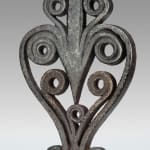Charles II Wrought Iron Love Token Meat Fork
ENGLAND, CIRCA 1680
51.5 x 7.25 x 0.8 cm
20 ¼ x 2 ¾ x ¼ in
20 ¼ x 2 ¾ x ¼ in
7122
Further images
Wrought with laminations, the stem flaring at its centre and its terminal and worked with scrolls to form a pair of hearts, with a hanging hook to the rear. J....
Wrought with laminations, the stem flaring at its centre and its terminal and worked with scrolls to form a pair of hearts, with a hanging hook to the rear.
J. Seymour Lindsay explains that: ‘[t]he seventeenth - and eighteenth-century iron flesh fork or ham fork with two or three prongs evolved from the iron three-barbed flesh hook, a common cooking implement of the Roman occupation.’ (‘Iron and Brass Implements of the English Domestic House’ (Alec Tiranti, London, 1970), p.34). He illustrates a number of 17th Century toasting forks. Figure 176 depicts a toasting fork wrought with similar scrolls and Figure 178 depicts a meat fork with similar heart-shaped decorations.
A similar fork wrought with scrolls was part of the Golding-Barrett Collection, subsequently sold by Thomas Coulborn & Sons.
J. Seymour Lindsay explains that: ‘[t]he seventeenth - and eighteenth-century iron flesh fork or ham fork with two or three prongs evolved from the iron three-barbed flesh hook, a common cooking implement of the Roman occupation.’ (‘Iron and Brass Implements of the English Domestic House’ (Alec Tiranti, London, 1970), p.34). He illustrates a number of 17th Century toasting forks. Figure 176 depicts a toasting fork wrought with similar scrolls and Figure 178 depicts a meat fork with similar heart-shaped decorations.
A similar fork wrought with scrolls was part of the Golding-Barrett Collection, subsequently sold by Thomas Coulborn & Sons.








